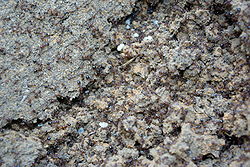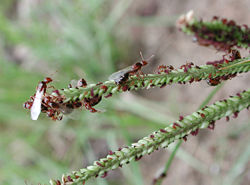Solenopsis invicta
Solenopsis invicta, often referred to as the red imported fire ant, or RIFA, is among the world's most infamous, aggressive and widespread invasive ant species. It is capable of causing serious medical, economic and ecologic problems wherever it occurs. The species is called the red imported fire ant because it is red, it was accidentally introduced into to the United States (imported), and the painful stings it inflicts cause a burning sensation (fire ant). In addition to being a nuisance species and a public health concern, RIFA has been documented to harm wildlife, including vertebrates and invertabrates. The species is also considered a pest because of the conspicuous nest mounds they build in the soil of open landscapes such as lawns, parks and agricultural fields. The mounds are known to reduce land values and agricultural productivty. Humans and other vertebrates are most often attacked after inadvertently disturbing a mound, which causes tens to hundreds of worker ants to pour out of their nest in defence. The sting of Solenopsis invicta has venom composed of a biocidal alkaloid, which causes burning pain and the formation of white pustules [1]. The species is native to South America, but has become established in the western and southern United States, the Caribbean, Australia, Taiwan, Hong Kong, and Macau [2], in addition to the southern Chinese provinces of Guangdong, Guangxi, Hunan, Fujian and Jiangxi [3].
引用
- , The Fire Ants. Cambridge, MA: Harvard University Press, 2006, p. 744.
- , “Global Invasion History of the Fire Ant Solenopsis invicta”, Science, vol. 331, no. 6020, pp. 1066 - 1068, 2011.
- , “An overview of the red imported fire ant (Hymenoptera: Formicidae) in Mainland China”, Florida Entomologist, vol. 90, no. 4, pp. 723 - 731, 2007.
Diagnosis of worker among Antkey species. Worker caste polymorphic. Total length > 2 mm. Head ovoid (minors) to rectangular (majors). Antenna 10-segmented. Antennal club 2-segmented. Antennal scapes not conspicuously short; easily extended beyond eye level. Antennal insertions at least partly covered by frontal lobes; not surrounded by a raised sharp-edged ridge. Antennal scrobe lacking. Posterolateral corners of head unarmed, without spines. Eyes medium to large (greater than 5 facets); distinctly less than half head length. Frontal lobes do not obscure face outline between mandible and eye. Anterior margin of clypeus with two lateral teeth and one median tooth. Mandibles triangular. Pronotal spines absent. Propodeum lacking spines or teeth. Petiole with peduncle; subpetiolar process not developed as a flange or lobe. Color shiny reddish brown.
Solenopsis invicta is easily separated from S. papuana by the polymorphic worker caste, the greater size (TL > 2.0 mm), and by the larger eye (> 5 facets). It is most reliably separated from S. geminata and S. xyloni by the presence of a median tooth between the two lateral teeth on the anterior margin of the clypeus. This character is often difficult to see, and it is best to examine a moderate sample of specimens of different sizes before a confident determination can be made. The species is further distinguished from the North American native, S. xyloni, by the lack of a well-developed subpetiolar process that forms a flange or lobe. Solenopsis invicta hybridizes with S. richteri. The two species are best distinguished by color (S. invicta is reddish brown and S. richteri is brownish black), but S. invicta x richteri is intermediate.
Solenopsis invicta is native to an elongate range in eastern Argentina centered on the Paraguay River [1][2][3]. The core of the range is a region called the Pantanal at the headwaters of the Paraguay River. The Pantanal is an expansive mosaic of flooded savannas and wetlands. Solenopsis invicta was introduced to Mobile, Alabama in the 1930's. The ants are believed to have originated from northeastern Argentina [4] and traveled to Mobile in a cargo ship. The original colonists included several mature colonies or combinations of mature colonies and colony-founding queens, and it is likely that additional immigration events occurred in subsequent years [3].
引用
- , “The red imported fire ant, Solenopsis invicta; distribution and habitat in Mato Grosso, Brazil”, Annals of the Entomological Society of America, vol. 67, pp. 43-46, 1974.
- , “Zoogeography of the imported fire ants”, Journal of the New York Entomological Society, vol. 82, pp. 113-124, 1974.
- , The Fire Ants. Cambridge, MA: Harvard University Press, 2006, p. 744.
- , “Distribution of the two social forms of the fire ant Solenopsis invicta (Hymenoptera: Formicidae) in the native South American range”, Annals of the Entomological Society of America, vol. 96, no. 6, pp. 810 - 817, 2003.
Know Your Farmer Alliance.
Emergency Response Plan for Invasive Ants in the Pacific - Draft 2 (Nov 29, 2008)
Vanderwoude Consulting Limited (New Zealand).
Fire Ant Management in the Home Lawn
Clemson University (South Carolina).
Fire Ants and Their Management (PDF | 291 KB)
Texas A&M University. Texas Agricultural Extension Service.
Imported Fire Ants - Publications for Control
University of Tennessee Extension.
Imported Fire Ant Program Manual (Updated Mar 2010; PDF | 2.4 MB)
USDA. APHIS. Plant Protection and Quarantine.
Managing Fire Ants
Texas A&M University. Texas Imported Fire ant Research and Management Project.
Managing Imported Red Fire Ants in Agriculture: A Regional Publication Developed for: Alabama, Arkansas, Georgia, Louisiana, Texas (PDF | 386 KB)
University of Tennessee. Agricultural Extension Service.
Managing Imported Fire Ants in Urban Areas (PDF | 4 MB)
Texas A&M University. Texas Agricultural Extension Service.


